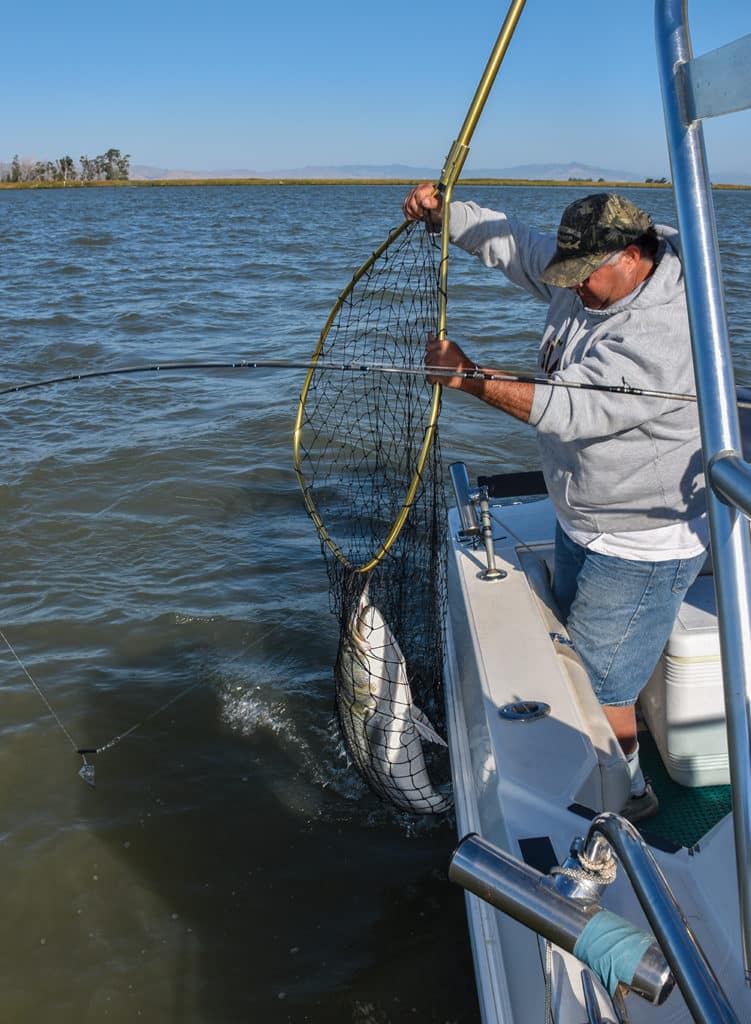
Like a hunting dog rushing to retrieve a bird, my friend Dave Scott jumped on the bent rod. Our third member, George Speris, the captain of the boat and a veteran on such encounters, gave over-the-shoulder advice to Scott. “Just let her go, but once that line starts rolling off at a blur, lock up, and when everything gets tight, nail her!” Scott followed the advice perfectly. The rod doubled over, followed with the usual pandemonium, and after some nervous moments with the net, Speris hauled in a shiny 25-pound striped bass.
As the tide kicked in, we had a busy morning, missing and connecting on bites. Eventually, we finished out with a respectable 28-pound fish.
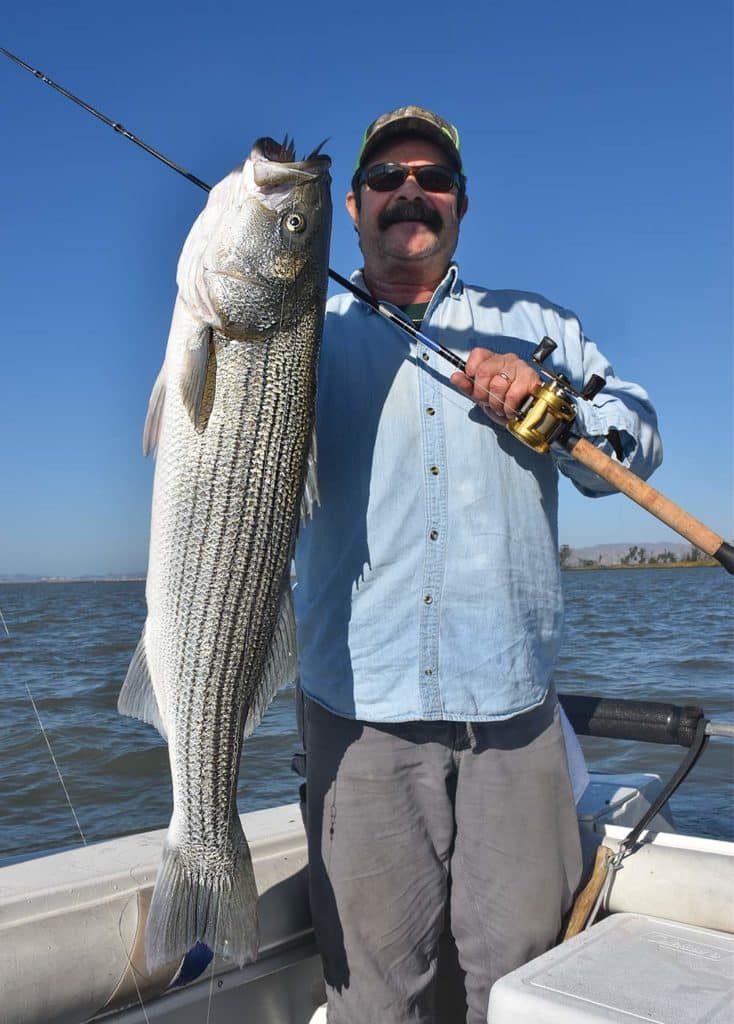
West Delta
The action took place on a channel edge, on the lower reaches of the delta, near Pittsburgh in northern California. Pittsburgh is well-known to anglers throughout the San Francisco Bay area, because this surrounding region features a diverse environment comprising shallow flats, channel edges, islands, cuts and numerous points that offer a wealth of opportunities for the striped bass addict.
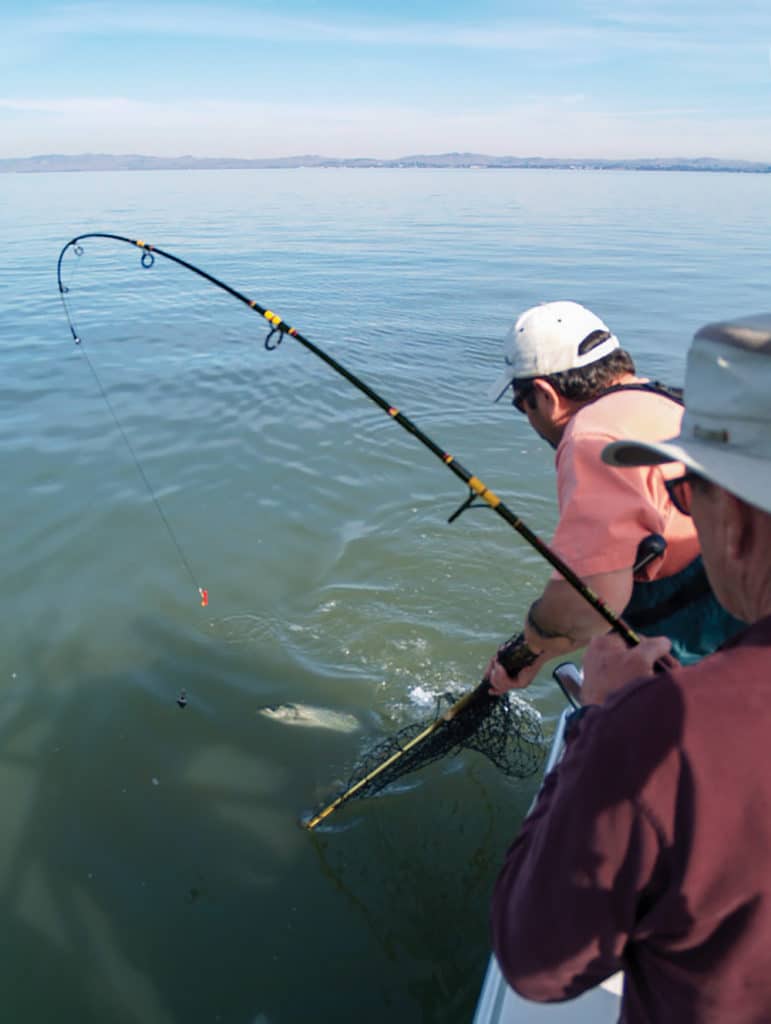
Prime Time
Late summer through fall is my favorite time to fish for stripers in this area. That’s when anchoring in the right spots is sure to produce steady action. During this period, stripers forage on the bottom, so bottomfishing with natural baits yields the best catches.
Because of the delta’s ongoing changes, you need good inside intelligence to know where and when to fish. Luckily, my buddy George Speris, who lives near the West Delta and guides in the area, does his homework. He launches from McAvoy Harbor, minutes from productive fishing grounds, and he’s gotten really good at the striper game. His most recent big fish topped 52 pounds.
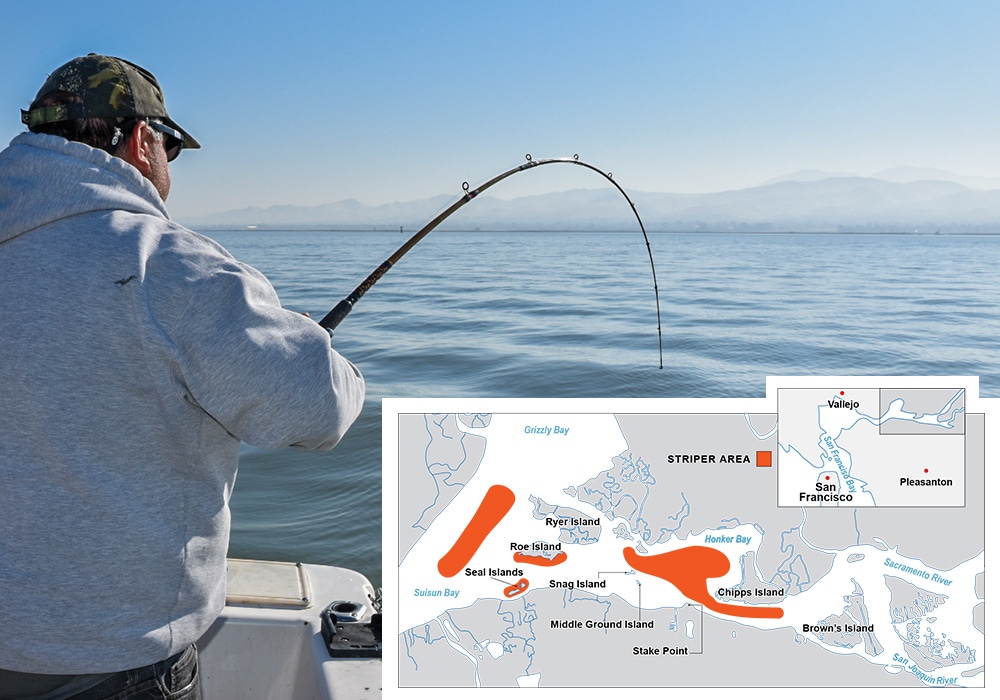
West Delta Spots
Two Options
I’ve had some great trips with Speris, and according to him, you have two basic options. If you’re after a potential wall hanger, set up in deeper water. If you want a lot of action with some decent keepers mixed in, go shallow.
When working shallow water, it’s best to anchor near points with a decent current, in depths from 5 to 15 feet like you’ll find at Seal Islands, Roe Island, Honker Bay and Snag Island, some of Speris’ favorite spots. These points offer a shallow sloping shelf that creates a distinct tidal rip with enough current. Bass stack up on the front edge of these rips, and a moderate to strong tide will kick-start the bite. Set up within casting distance of the point and drop anchor, then cast tight against the point to put your bait right in front of these edges.
Fish your bait on the bottom, with the reel on free-spool and the clicker on. Initial sharp raps are an early warning sign of a bite, before the line starts taking off. If the fish are there, the action comes quickly. So move to another point if nothing happens in a little while.
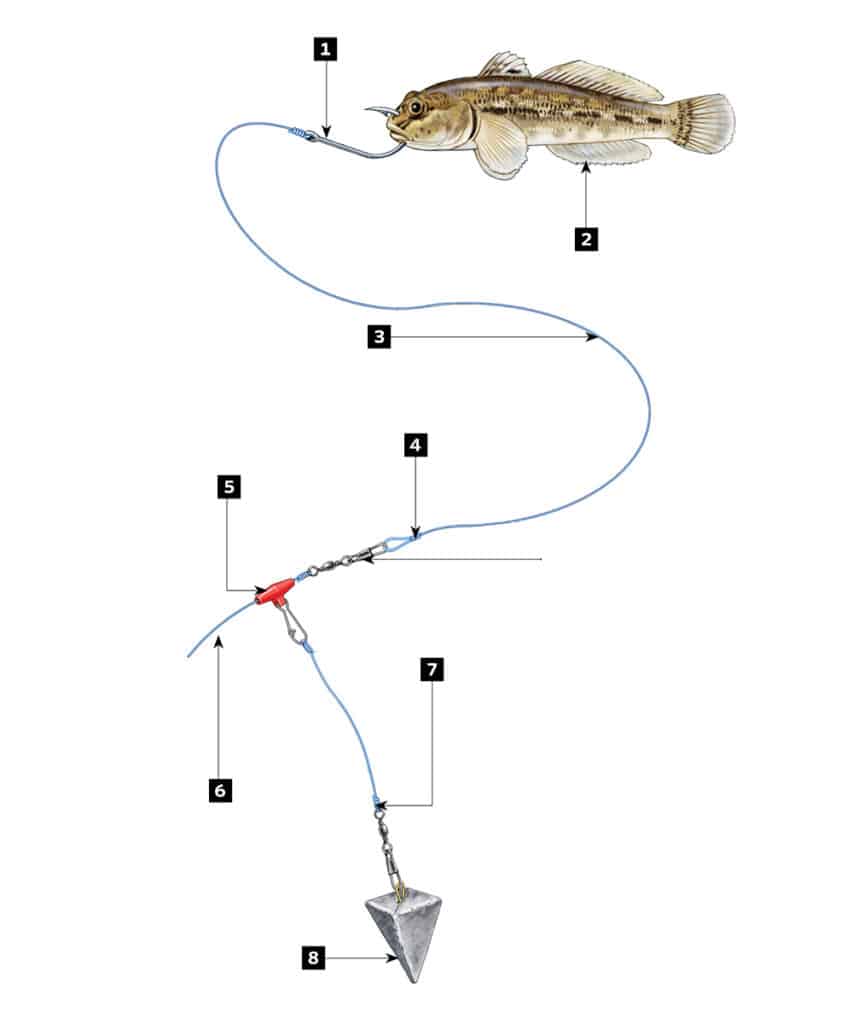
Shallow Bait Rig
[2] Live goby
[3] 4 feet of 25- to 40-pound fluoro leader
[4] Surgeon’s loop
[5] Sinker slide
[6] Main line (30- to 50-pound braid or 20- to 30-pound mono)
[7] Dropper with 1/0 snap swivel
[8] 2- to 6-ounce pyramid sinker Steve Sanford
Shallow Setup
Any quality 7- to 8-foot stick matched with a conventional or baitrunner-style spinning reel loaded with 30- to 50-pound braid will do. Terminal gear should include 2- to 6-ounce sinkers to cover various depths and currents, and a plastic sinker slide, to which you tie a short 6-inch dropper with a snap on the end to hang the sinker. This keeps the live bait just off the bottom.
Thread the main line through the sinker slide, then tie a 1/0 snap swivel on the end to attach the leader: a 4-foot section of 40-pound fluorocarbon with a surgeon’s loop and a hook — matched to the bait — tied at opposite ends.
Rigging Baits
Some of the top baits include threadfin shad, gobies (aka mud suckers) and staghorn sculpin (aka bullheads). When using a live goby or staghorn sculpin, pin a single 3/0 to 4/0 beak-style hook upward through both lips. If opting for live threadfin shad, use two baits and a tandem of 1/0 hooks, embedding a hook through the nostrils on each shad. Big baits will require 5/0 double hooks and the use of a rigging needle to place them properly.
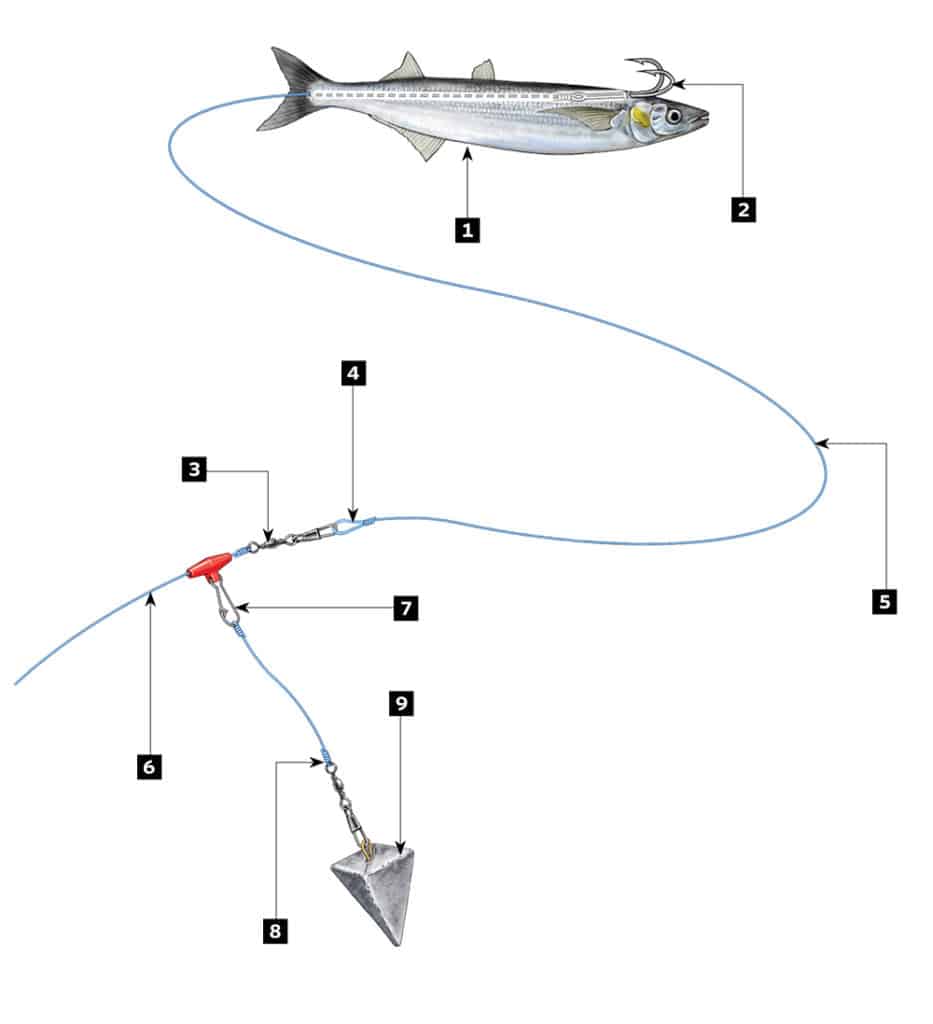
Trophy Bass Rig
[3] 1/0 snap swivel
[4] Surgeon’s loop
[5] 4 feet of 25- to 40-pound fluoro leader
[6] Main line (30- to 50-pound braid or 20- to 30-pound mono) [7] Sinker slide
[8] Dropper with 1/0 snap swivel
[9] Pyramid sinker (weight based on current) Steve Sanford
Deep Trophies
When going after the larger stripers, Speris fishes deeper water — from 25 to 35 feet, along channel slopes — and uses only big baits. He explains that you need big baits, weak to moderate tides are preferred, and being patient is crucial.
Trophy stripers on the delta have a fondness for jacksmelt and split tails. They’re not sold in tackle shops but can be caught in local waters. For split tails, fish sloughs using light tackle and a bait leader setup with small hooks baited with chunks of earthworm. For jacksmelt, try any shallow points in San Francisco Bay, using small spinners or spoons, or small baited hooks. Anglers are allowed two split tails per day, and there’s no limit on jacksmelt.
For big bass in the 30- to 50-pound range, there’s tons of productive real estate to cover in the West Delta. But the big fish are known to hug channel edges, and those from the firing line to the PG&E plant generally get the most attention. It pays to follow the contour of a channel, scanning the slope before dropping anchor. Once you pick up marks on the fish finder, you can anchor right over the fish.
Wide Coverage
You’re allowed to fish two rods per angler, and to maximize coverage, it’s best to fan-cast the baits over a broad area. Then place the reels in free-spool with the clickers on and wait for the bass to zero in.
The initial strike, in most cases, starts with a sharp rap on the rod tip. But you can’t be too quick on the trigger. If it’s a fish with big shoulders, you’ll first detect some tentative pulls on the line before it starts dumping off the reel at an alarming rate. Even then, you should wait a bit more to give the fish time to turn the bait and take it completely in its mouth. When it gets to the point that you can’t stand it anymore, engage the reel and set the hook. Then just hang on and enjoy the adrenaline rush.
SWS Planner: Northern California Stripers
What: Striped bass
Where: Northern California’s West Delta
When: Late summer through fall
Who: Striper fishing in the West Delta is conducive to DIY fishing, but the following charter captains can shorten the learning curve.
Captains Barry and Diane Canavero
Fish Hookers
916-870-4225
fishon@fishhookers.com
Capt. Jay Lopes
Right Hook Sportfishing
916-417-5670
righthook12@yahoo.com
Capt. Mike Gravert
Intimidator Sportfishing
916-806-3030
intimidatorsportfishing.com
SWS Tackle Box: Northern California Stripers
Rods: 7- to 8-foot live-bait rod with a sensitive tip, rated for 10- to 20- or 12- to 25-pound line, like the Cousins F196 and F270, or equivalent
Reels: Matching conventional or levelwind reel with clicker and at least 200-yard line capacity, like the Penn 965, 975 and 220LD, or equivalent
Line: 30- to 50-pound braid or 20- to 30-pound mono, and 25- to 40-pound fluoro leader
Terminal Gear: Sliding sinker sleeve, 2- to 6-ounce cannonball or pyramid sinker, size 1 to 1/0 snap swivel, 1/0 to 3/0 beak-style hooks, and 4/0 to 5/0 double hooks
Bait: Threadfin shad, bullheads, long-jaw mud suckers and gobies are sold at local bait shops; jacksmelt and split tails can be caught with hooks baited with worm or pile worm. Anglers are allowed two split tails per day. Jacksmelt have no limit. A stainless rigging needle is necessary to rig the larger baits.









